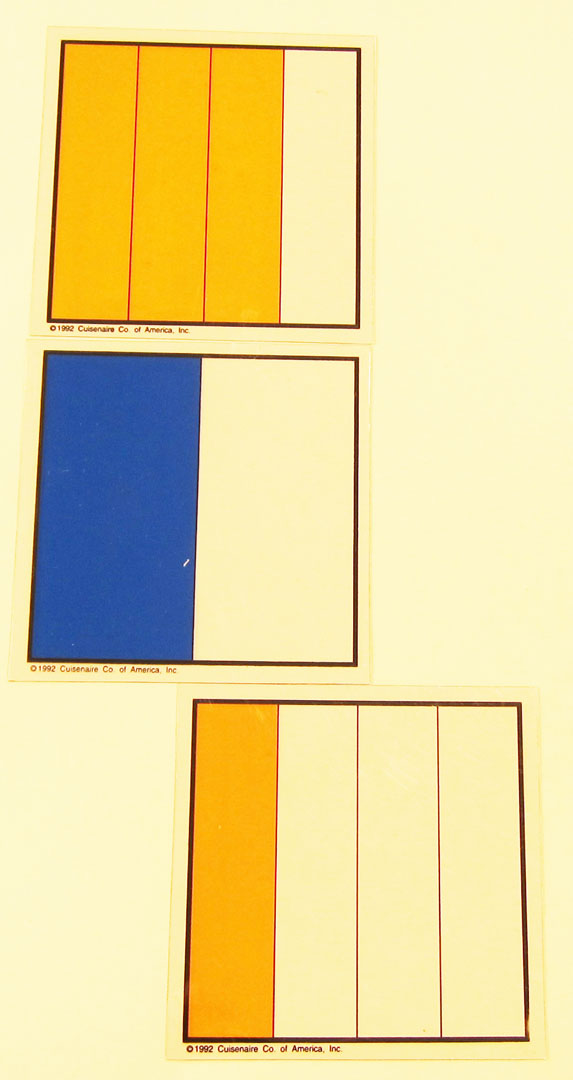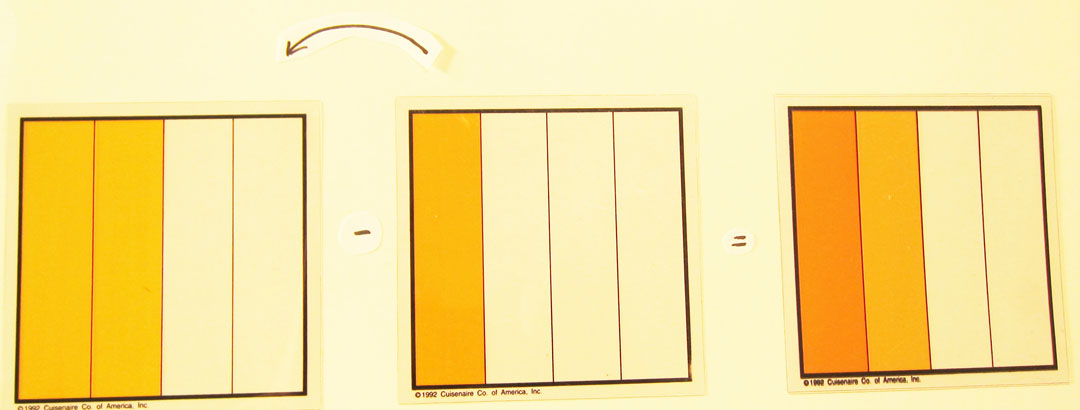Fun with Picture Grids: Teaching the Subtraction of Fractions
Order a set at: http://www.hand2mind.com/catalog/product?deptId=&prodId=020272&q=picture+gridsPart II: Teaching Subtraction with the Picture Grids Manipulatives
Henry continues using the Picture Grid materials to teach subtraction:
1. “The grids can also be used to do subtraction,” Henry says. “Let’s take the problem of one-half minus one-fourth.” He hands out the halves grid, the fourths grid, the clear grid, and a bunch of colored pencils. He tells the students to solve the problem. One group takes the quarters grid and overlays it directly on top of the halves. “Good,” Henry says. “Which is the part being taken away?” The students are quick to respond, “The darker area!” Henry nods. “And the result?” he asks. “The lighter shade,” they chorus. They can easily see from this example that the final result is one quarter.
Illustration: ½ – ¼ = 1/4
2. Henry knows that some examples are not quite so obvious, but he is encouraged by the students’ enthusiasm. He leads a group to solve subtraction in another way. He asks them to take different grids and place them beneath each other to determine the amount left. He says, “This is called comparative subtraction. We can compare two fractions without taking things away. Let’s say you have a 3/4 pizza pie, and I have a 1/2 pizza pie. Who has more and by how much? Try to figure this out:
Illustration:
¾
½
This is the amount that is different: = 1/4
A few students lined up the halves grid under the 3/4 grid. One student explained, “I measured the difference and used another grid to figure out what the size of the piece left was equal to.”
3. Henry takes another group and pulls out colored grids, clear grid, and the colored wax pencils. He asks the students to use these items to solve the problem. The group fills in two quarters and wipes away one quarter. “The answer?” he asks. “One quarter!” the students answer.
Illustration:
½ , 2/4, 2/4 – ¼ = ¼
At this point, Henry brings the class together and has each group teach the other. Both Henry and the students prompt the teaching group with questions. Henry marvels at how easily they teach each other.
4. The next week Henry says, “There is still another way of using the picture grids to do subtraction. It’s called the system of exchange. Let’s use the example of one half minus one quarter. Let’s see what you can figure out in your cooperative learning group.” One group says, “If we exchange the one half for two quarters, then we can easily subtract the one quarter from the two quarters.”
Illustration:
½ -> 2/4 – 1/4 = 1/4
He watches as another group places a quarters grid on top of the two-quarters grid. “Good” he encourages them. “Which is the area being taken away?” The students shout in unison, “The darker area!” Henry smiles. “Yes,” he says. “And the area that remains?” The students are too excited to wait to be called on. “The lighter area!” they shout. Henry smiles again. Success is very sweet.
Illustration:
2/4 – ¼ = ¼
Once again, the groups teach each other!
At this point, students are encouraged to create their own scenarios with the grids to practice. With repetition, they get the hang of it. Then, Henry asks them to write one of their scenarios along with the diagrams in their Pic-Jour Math journal. Not until Henry is convinced that the pictures/diagrams are strongly linked to the numbers, does Henry move them away from the manipulatives and just use numbers in his teaching practices.
There are various ways to teach the subtraction of fractions with the picture grids.
Please continue onto the next section, Fun with Picture Grids, Teaching Multiplication & Decimals
Andi Stix is an educational consultant & coach who specializes in differentiation, interactive learning, writing across the curriculum, classroom coaching, and gifted education. For further information on her specialties or social media, please email her on the Contact page.
(c) 1992 Picture Grids designed by Andi Stix, Produced by ETA/Cuisenaire Company of America.
A Math Manipulative to Teach Fractions and Decimals, © 1993 Speech by Andi Stix, Ed.D.Association of Mathematics Teachers of New York State, Buffalo, NY,ERIC: Eric Resources Information Center #ED408158 (c) 1992 Picture Grids designed by Andi StixOriginally Produced by ETA/Cuisenaire Company of America.References
Schubert, B. (1987). Mathematics journals: Fourth grade. In Toby Fulwiler (Ed.), The Journal Book. (348-358). Portsmouth, NH Boynton/Cook Publishers.
Stix, Andi N. (1992).The Development and Field Testing of a Multi-Modal Method for Teaching Mathematical Concepts to Preservice Teachers by Utilizing Pictorial Journal Writing. Ph.D. diss. Columbia University Teachers College. Ann Arbor, MI: U.M.I. Dissertation Information Service, Pub. #92-18719.
Stix, Andi N. (1994). Pictorial journal writing in mathematics. Arithmetic Teacher, 42:1, 264-269.












